
Mechanical Properties of Solids Class 11 Physics is about solid's properties, which states that solid bodies are not perfectly rigid. Solid has a definite shape and size. The solid's shape and size can be changed by applying force. Even for a rigid steel bar, it can be deformed by applying a large external force. Mechanical properties of fluids class 11 NCERT solutions cover the concept of elasticity, plasticity, stress and strain, Hooke's law, elastic moduli, stress-strain curve, and applications of elastic behavior of materials.
Physics Class 11 Mechanical Properties of Solids PDF is also available for students. The well-structured solutions given in the PDF will help students to improve their problem-solving skills and to get high scores in the CBSE Board exam and other competitive exams.
Students preparing for CBSE board and NEET, and JEE exams can access the complete Class 11 Physics Notes and get the solved examples, weightage information, important topics, and chapter-wise free PDFs.
Related Links
| NCERT Class 11 Notes | NCERT Notes for Class 11 & 12 | NCERT Solutions Physics Class 11th |
- NCERT Solutions for Class 11 Physics Chapter 8 Mechanical Properties of Solids: Key Concepts, Weightage
- NCERT Physics Class11th Solution PDF for Mechanical Properties of Solids
- NCERT Physics Class11th Mechanical Properties of Solids Solutions
NCERT Solutions for Class 11 Physics Chapter 8 Mechanical Properties of Solids: Key Concepts, Weightage
The Mechanical Properties of Fluids Class 11 Physics is a crucial chapter for students planning to appear in the competitive exams later. In NEET, it has moderate weightage, and its questions also appear in the JEE Mains. The key topics on which students should focus are stress and strain, Hooke's law, elasticity, and elastic potential energy.
See below the topics covered in this chapter:
| Exercise | Topics Covered |
|---|---|
| 8.1 | Introduction |
| 8.2 | Stress and Strain |
| 8.3 | Hooke's Law |
| 8.4 | Stress-Strain Curve |
| 8.5 | Elastic Moduli |
| 8.6 | Applications of Elastic Behaviour of Materials |
Mechanical Properties of Fluids Weightage in NEET, JEE Mains
| Exam | Number of Questions |
|---|---|
| NEET | 1-2 questions |
| JEE Main | one question |
NCERT Physics Class11th Solution PDF for Mechanical Properties of Solids
Students must download the Physics Class 11 Mechanical Properties of Solids PDF from the link given below. It covers all the NCERT textbook questions of this chapter. The solutions help students to deepen their understanding of concepts and boost their confidence to score high in the CBSE and other competitive exams.
Download Here: NCERT Solution for Class XI Physics Chapter Mechanical Properties of Solids PDF
NCERT Physics Class11th Mechanical Properties of Solids Solutions
| Q.9.1 A steel wire of length 4.7 m and cross-sectional area 3.0 × 10-5 m2 stretches by the same amount as a copper wire of length 3.5 m and cross-sectional area of 4.0 × 10–5 m2 under a given load. What is the ratio of the Young’s modulus of steel to that of copper? |
| Ans.9.1 Length of the steel wire, = 4.7 m Area of cross-section of the steel wire, = 3.0 m2 Length of the copper wire, = 3.5 m Area of cross-section of the copper wire, = 4.0 m2 Change in length, Let the force applied = F Young’s modulus in steel wire, = …..(1) Young’s modulus in copper wire, = …….(2) The ratio of Young’s modulus = = = = |
| Q.9.2 Figure 9.11 shows the strain-stress curve for a given material. What are (a) Young’s modulus and (b) approximate yield strength for this material? |
| Ans.9.2 From the given graph, for the value stress 150 N/ , the strain is 0.002 Young’s modulus = = 7.5 N/ Yield strength is the maxium strength the material can withstand in elastic limit. From the graph, the yield strength is 300 or 3 |
| Q.9.3 The stress-strain graphs for materials A and B are shown in Fig. 9.12. The graphs are drawn to the same scale. (a) Which of the materials has the greater Young’s modulus?
(b) Which of the two is the stronger material? |
| Ans.9.3 Material A has greater Young’s modulus. Material A is the strongest as it can withstand more strain than material B without fracture. |
| Q. 9.4 Read the following two statements below carefully and state, with reasons, if it is true or false. The Young’s modulus of rubber is greater than that of steel The stretching of a coil is determined by its shear modulus |
| Ans.9.4 For a given stress, the strain in rubber is more than it is in steel, hence the Young’s modulus of rubber is lesser than in steel. So the statement is False. Shear modulus is the ratio of the applied stress to the change in the shape of a body. The stretching of a coil changes its shape. Hence, shear modulus of elasticity is involved in this process.
= 2.2 |
Commonly asked questions
9.5 Two wires of diameter 0.25 cm, one made of steel and the other made of brass are loaded as shown in Fig. 9.13. The unloaded length of steel wire is 1.5 m and that of brass wire is 1.0 m. Compute the elongations of the steel and the brass wires.
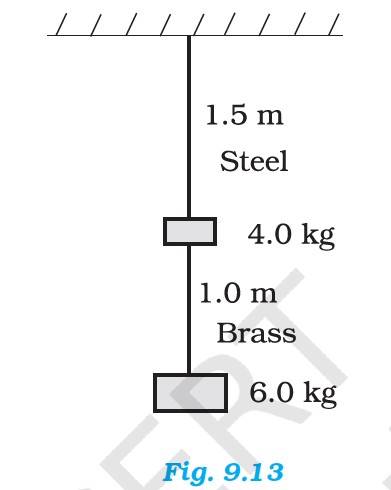
Diameter of wires, d = 0.25 cm, radius, r = 0.125 cm
Cross-sectional area, = = = 4.908
Length of the steel wire, , length of the brass wire,
Change in length of the steel wire Change in length of the copper wire
Total force exerted on the steel wire, = ( 4+6) kg = 10 kg = 98 N
Young’s modulus of steel , = = 2.0 Pa
= = 1.497 m
Similarly for brass wire, = 6 kg = 58.8 N, =
= = 1.316 m
9.7 Four identical hollow cylindrical columns of mild steel support a big structure of mass 50,000 kg. The inner and outer radii of each column are 30 and 60 cm respectively. Assuming the load distribution to be uniform, calculate the compressional strain of each column.
Mass of the big structure, M = 50000 kg = 50000 = 4.9 N
Inner radius of the column, r = 30 cm = 0.3 m
Outer radius of the column, R = 60 cm = 0.6 m
Young’s modulus of steel, Y = 2 Pa
Total force exerted on 4 columns, F = 4.9 N
Force exerted on single column, f = F/4 = 1.225 N
Cross sectional area of each column, A = = = 0.848
Stress in each column = f/A
Young’s modulus, Y = Stress / Strain, Strain = Stress / Y = f/ (A = m
9.15 Determine the volume contraction of a solid copper cube, 10 cm on an edge, when subjected to a hydraulic pressure of 7.0 × 106 Pa.
Length of an edge of the solid copper cube, l = 10 cm = 0.1 m
Volume of the copper cube = 1
Hydraulic pressure, p = 7.0 Pa
Bulk modulus of copper, k = 140 Pa
From the relation k = we get = = = 5
9.13 What is the density of water at a depth where pressure is 80.0 atm, given that its density at the surface is 1.03 × 103 kg m–3?
Let us assume the depth = h, pressure at depth, = 80 atm = 80 Pa
Density of water at the surface, = 1.03 kg/
Let density of water at depth h be
Let be the volume at the surface and be the volume at depth h and ΔV be the change in volume. Let m be the mass of water.
ΔV = From the relation m = we get
ΔV = m ( - ) = ( - )
= 1- ……(i)
Bulk modulus of water, k = =
= ……..(ii)
Bulk modulus of water, k = 2.1 Pa
Hence = 3.86
From equation (i) = 0.99614
= 1.034 kg/
9.8 A piece of copper having a rectangular cross-section of 15.2 mm × 19.1 mm is pulled in tension with 44,500 N force, producing only elastic deformation. Calculate the resulting strain?
Area of cross-section, A = 15.2 mm = 15.2
Force, F = 44500 N
Stress, F/A = (44500/ N/
Modulus of elasticity, = Stress / Strains, Strains = Stress /
For copper, = 42
Strains = (44500/ 42 = 3.65
9.6 The edge of an aluminium cube is 10 cm long. One face of the cube is firmly fixed to a vertical wall. A mass of 100 kg is then attached to the opposite face of the cube. The shear modulus of aluminium is 25 GPa. What is the vertical deflection of this face?
Edge of the aluminium cube, L = 10 cm = 0.1 m, Area A = 0.01
Mass attached, m = 100 kg = 100 9.8 = 980 N = Applied force F
Shear modulus = 25 GPa = 25
Shear modulus = Shear stress / Shear strain = , = = 3.92
9.9 A steel cable with a radius of 1.5 cm supports a chairlift at a ski area. If the maximum stress is not to exceed 108 N m–2, what is the maximum load the cable can support?
Area of cross-section, A = = 7.07
Maximum stress = Maximum load / cross sectional area
Maximum load = Maximum stress cross sectional area = 108 7.07 = 7.07 N
9.11 A 14.5 kg mass, fastened to the end of a steel wire of unstretched length 1.0 m, is whirled in a vertical circle with an angular velocity of 2 rev/s at the bottom of the circle. The cross-sectional area of the wire is 0.065 cm2. Calculate the elongation of the wire when the mass is at the lowest point of its path.
Mass, m = 14.5 kg
Length of the steel wire, l = 1.0 m
Angular velocity, = 2 rev/s
Cross sectional area of the wire, A = 0.065 = 0.065
Let Δl be the elongation of the wire
When the mass is placed at the position of the vertical circle, the total force on the mass is
F = mg + ml = 14.5 = 200.25 N
Young’s modulus for steel, = Stress / Strain = 2 Pa
Stress = F/A = 200.25/0.065
Strain = (Δl/l) = (Δl/1) = Δl
Δl = (200.25/0.065 2 = 1.54 m
9.12 Compute the bulk modulus of water from the following data: Initial volume = 100.0 liter, Pressure increase = 100.0 atm (1 atm = 1.013 × 105 Pa), Final volume = 100.5 liter. Compare the bulk modulus of water with that of air (at constant temperature). Explain in simple terms why the ratio is so large.
Initial volume, = 100 lit = 100
Final volume, = 100.5 lit = 100.5
Increase in volume, ΔV = = 0.5
Increase in pressure, ΔP = 100 atm = 100 1.013
Bulk modulus, k = = Pa = 2.026 Pa
Bulk modulus of air = 1.0
(Bulk modulus of water / Bulk modulus of air) = (2.026 1.0 = 2.026
This higher ratio is attributed to the higher compressibility of air than water.
9.4 Read the following two statements below carefully and state, with reasons, if it is true or false.
The Young’s modulus of rubber is greater than that of steel
The stretching of a coil is determined by its shear modulus
For a given stress, the strain in rubber is more than it is in steel, hence the Young's modulus of rubber is lesser than in steel. So the statement is False.
Shear modulus is the ratio of the applied stress to the change in the shape of a body. The stretching of a coil changes its shape. Hence, shear modulus of elasticity is involved in this process.
= 2.2
9.21 The Marina trench is located in the Pacific Ocean, and at one place it is nearly eleven km beneath the surface of water. The water pressure at the bottom of the trench is about 1.1 × 108 Pa. A steel ball of initial volume 0.32 m3 is dropped into the ocean and falls to the bottom of the trench. What is the change in the volume of the ball when it reaches to the bottom?
Water pressure at the bottom, p = 1.1 Pa
Initial volume of the steel ball, V = 0.32
Bulk modulus of the steel, B = 1.6 N/
The ball falls at the bottom of the Pacific ocean which is 11 km beneath the surface
Let the change in volume of the ball on reaching the bottom of the trench be ΔV
We know, bulk modulus, B = or ΔV =
ΔV = = 2.2
9.14 Compute the fractional change in volume of a glass slab, when subjected to a hydraulic pressure of 10 atm.
Hydraulic pressure exerted on glass slab, p = 10 atm = 10 Pa
Bulk modulus of glass, k = 37 N
From the relation k = , we get = = = 2.976
9.16 How much should the pressure on a liter of water be changed to compress it by 0.10%?
Volume of water, V = 1 liter. If the water is compressed by 10%, then
ΔV = 0.10% of V= (0.1/100) = 1
Bulk modulus of water, k = 2.2 N/
From the relation, k = , we get ΔP = k = 2.2 1 = 2.2 N/
9.20 Two strips of metal are riveted together at their ends by four rivets, each of diameter 6.0 mm. What is the maximum tension that can be exerted by the riveted strip if the shearing stress on the rivet is not to exceed 6.9 × 107 Pa? Assume that each rivet is to carry one quarter of the load.
Diameter of the metal strip, d = 6.0 mm = 6 m
Radius, r = d/2 = 3 m
Maximum shearing stress = 6.9 Pa =
Maximum force = Maximum stress
= 6.9 = 6.9 = 1950.93 N
Since each rivet carries 1/4th of load,
Maximum tension on each rivet = 4 N = 7803.72 N
9.1 A steel wire of length 4.7 m and cross-sectional area 3.0 × 10-5 m2 stretches by the same amount as a copper wire of length 3.5 m and cross-sectional area of 4.0 × 10–5 m2 under a given load. What is the ratio of the Young’s modulus of steel to that of copper?
Length of the steel wire, = 4.7 m
Area of cross-section of the steel wire, = 3.0 m2
Length of the copper wire, = 3.5 m
Area of cross-section of the copper wire, = 4.0 m2
Change in length,
Let the force applied = F
Young’s modulus in steel wire,
= …..(1)
Young’s modulus in copper wire,
= …….(2)
The ratio of Young’s modulus
= = = =
9.2 Figure 9.11 shows the strain-stress curve for a given material. What are (a) Young’s modulus and (b) approximate yield strength for this material?
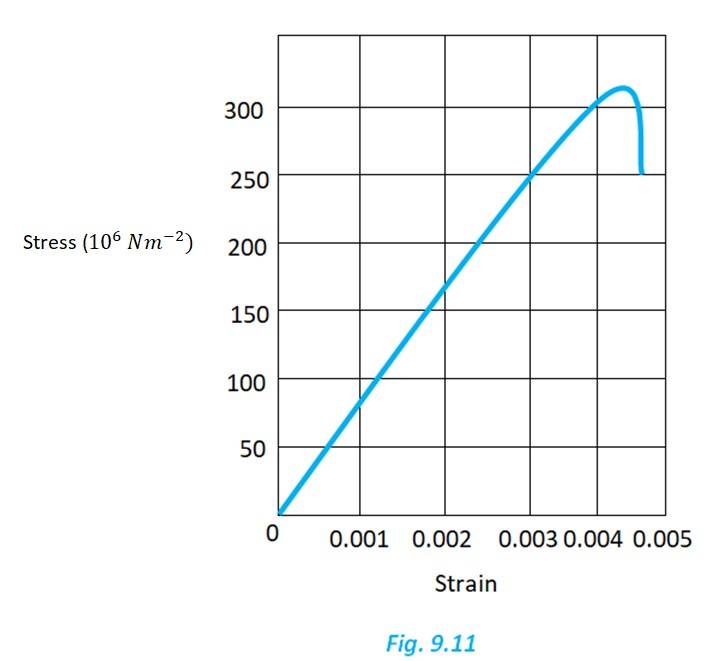
From the given graph, for the value stress 150 N/ , the strain is 0.002
Young's modulus = = 7.5 N/
Yield strength is the maxium strength the material can withstand in elastic limit. From the graph, the yield strength is 300 or 3
9.3 The stress-strain graphs for materials A and B are shown in Fig. 9.12.
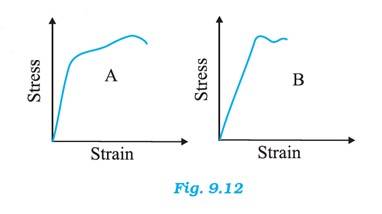
The graphs are drawn to the same scale.
(a) Which of the materials has the greater Young’s modulus?
(b) Which of the two is the stronger material?
Material A has greater Young's modulus.
Material A is the strongest as it can withstand more strain than material B without fracture.
9.10 A rigid bar of mass 15 kg is supported symmetrically by three wires each 2.0 m long. Those at each end are of copper and the middle one is of iron. Determine the ratios of their diameters if each is to have the same tension.
It is given that the tension, F in each wire is same. Since the wire is of same length, Strain also will be same.
If is the diameter of copper wire and Young’s modulus of copper = 110 and strain is s, then = ,
Similarly, if is the diameter of iron wire and is the Young’s modulus of iron = 190 , then =
= = = 1.314
9.17 Anvils made of single crystals of diamond, with the shape as shown in Fig. 9.14, are used to investigate behavior of materials under very high pressures. Flat faces at the narrow end of the anvil have a diameter of 0.50 mm, and the wide ends are subjected to a compressional force of 50,000 N. What is the pressure at the tip of the anvil?
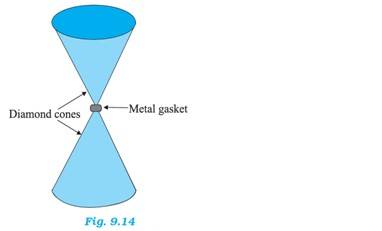
Diameter of the cone at the narrow end, d = 0.5 mm = 0.5 m
Radius, r = d/2 = 0.25 m
Area, A = = 1.96
Compressional force, F = 50000 N
Pressure at the tip of the anvil, p = F/A = 50000/1.96 Pa = 2.54 Pa
9.18 A rod of length 1.05 m having negligible mass is supported at its ends by two wires of steel (wire A) and aluminium (wire B) of equal lengths as shown in Fig. 9.15. The cross-sectional areas of wires A and B are 1.0 mm2 and 2.0 mm2, respectively. At what point along the rod should a mass m be suspended in order to produce (a) equal stresses and (b) equal strains in both steel and aluminium wires.
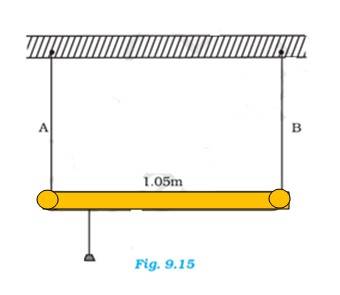
Cross-sectional area of wire A, = 1 = 1
Cross-sectional area of wire B, = 2 = 2
Young’s modulus for steel, = 2 N/
Young’s modulus for aluminium, = 7 N/
Stress in the wire = =
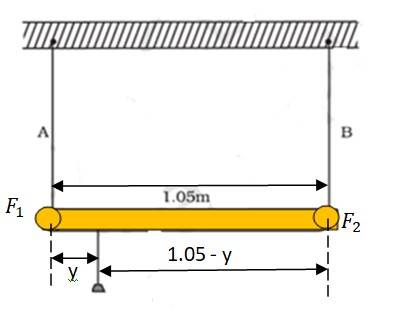
If the two wires have equal stresses, then
= or = = ………(i)
Where is the force exerted on steel wire and is the force exerted on aluminium wire
Taking a moment around the point of suspension, we get
=
= ……(ii)
Using equation (i) and (ii), we can write
or y = 2.1 – 2y or y = 2.1/3 = 0.7 m
We know Young’s modulus Y = Stress / Strain
Y = (F/A)/ Strain or Strain = (F/A)/Y
In case of Steel wire, =
In case of Aluminium wire, =
Since both the strains are equal, we get
= = = 1.429
From (ii) we get
= 1.429
y = 0.432m
In order to produce an equal strain in the two wires. The mass should be suspended at a distance of 0.432m from the end A
9.19 A mild steel wire of length 1.0 m and cross-sectional area 0.50 × 10-2 cm2 is stretched, well within its elastic limit, horizontally between two pillars. A mass of 100 g is suspended from the mid-point of the wire. Calculate the depression at the midpoint.
Length of the mild steel wire, l = 1.0 m
Area of cross-section, A = 0.5 = 0.5
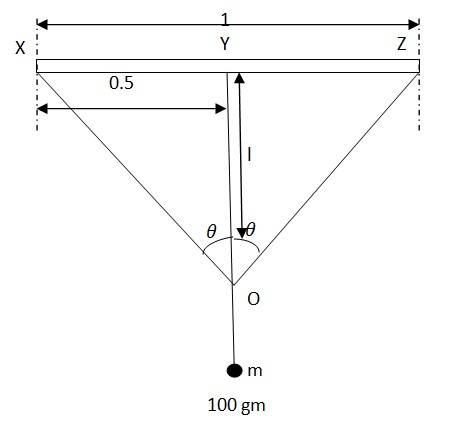
A mass of 100 gm is suspended at the midpoint.
m = 100 gm= 0.1 kg
Due to the weight, the wire dips, as shown in the figure.
Original length = XZ, depression = l
The final length of the wire after it dips = XO + OZ
Increase in length of the wire, Δl = (XO + OZ) – XZ ……(i)
From Pythagoras theorem
XO = OZ =
From equation (i)
Δl = 2 - 1.0 = 2 - 1.0 = - 1.0
Neglecting the smaller terms, we can write, Δl =
We know, Strain =
Let T be the tension in the wire, then
mg = 2T
From the figure
= = =
Expanding the expression and eliminating the higher terms:
=
Since ( 1+ ) = 1 for small l, =
Then T = = =
Stress = =
Young’s modulus =
Y =
l=
For steel, Y = 2 Pa, then
l = = 0.0106 m
Hence, the depression at the midpoint is 0.0106 m
Explore exams which ask questions on physics ncert solutions class 11th
Select your preferred stream
physics ncert solutions class 11th Exam
Student Forum
Other Similar chapters for you
- Physical World
- Units and Measurements
- Motion in a Straight Line
- Motion in a Plane
- Laws of Motion
- Work, Energy, and Power
- System of Particles and Rotational Motion
- Gravitation
- Mechanical Properties of Solids
- Mechanical Properties of Fluids
- Thermal Properties of Matter
- Thermodynamics
- Kinetic Theory
- Oscillations
- Waves
Popular Courses After 12th
Exams accepted
CA FoundationExams accepted
ICSI ExamExams accepted
BHU UET | GLAET | GD Goenka TestBachelor of Business Administration & Bachelor of Law
Exams accepted
CLAT | LSAT India | AIBEExams accepted
IPMAT | NMIMS - NPAT | SET
Exams accepted
BHU UET | KUK Entrance Exam | JMI Entrance ExamBachelor of Design in Animation (BDes)
Exams accepted
UCEED | NIFT Entrance Exam | NID Entrance ExamBA LLB (Bachelor of Arts + Bachelor of Laws)
Exams accepted
CLAT | AILET | LSAT IndiaBachelor of Journalism & Mass Communication (BJMC)
Exams accepted
LUACMAT | SRMHCAT | GD Goenka Test
